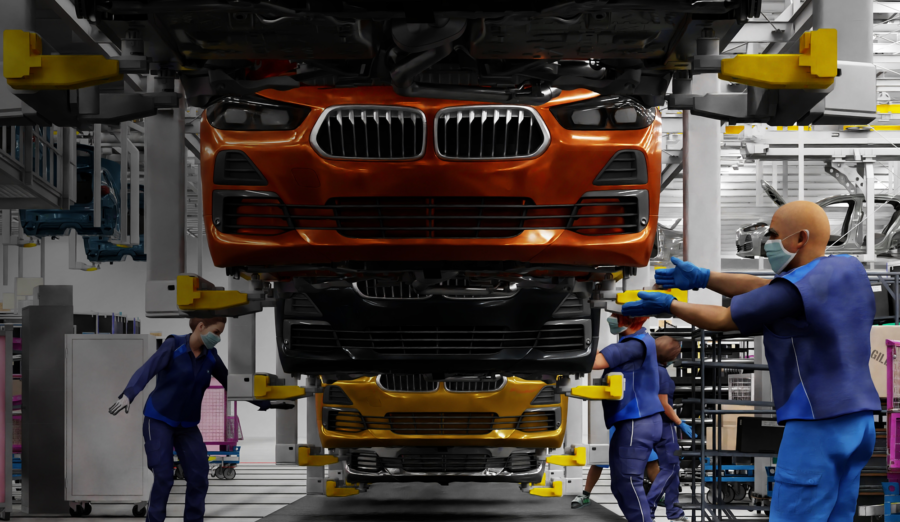
March 22, 2022 – NVIDIA has today announced NVIDIA OVX, a computing system designed to power large-scale digital twins. According to the company, NVIDIA OVX is purpose-built to operate complex digital twin simulations that will run within NVIDIA Omniverse, a real-time physically accurate world simulation and 3D design collaboration platform.
A digital twin is a virtual representation that serves as a real-time digital counterpart of a physical object or process. Digital twins are being used to train AIs in order to help predict and optimize operational performance. Digital twins can also be linked to their physical operational counterparts and updated with sensor data so that the state of these physical objects can be assessed in real time.
The OVX system combines high-performance GPU-accelerated compute, graphics and AI with high speed storage access, low-latency networking and precision timing to provide the performance required for creating digital twins with real-world accuracy. OVX will be used to simulate complex digital twins for modeling entire buildings, factories, cities and even the world.
“Physically accurate digital twins are the future of how we design and build,” said Bob Pette, Vice President of Professional Visualization at NVIDIA. “Digital twins will change how every industry and company plans. The OVX portfolio of systems will be able to power true, real-time, always-synchronous, industrial-scale digital twins across industries.”
NVIDIA stated that OVX will enable designers, engineers, and planners to build physically accurate digital twins of buildings or create massive, true-to-reality simulated environments with precise time synchronization across physical and virtual worlds. This will enable companies to evaluate and test complex systems and processes with multiple autonomous systems interacting in the same space-time to optimize, expand, or create more efficient factories and warehouses or train robots and autonomous vehicles before deploying them in the physical world.
Developing Digital Twins
Within the sector initiative “Digitale Schiene Deutschland” (Digital Rail for Germany), DB Netze is building in Omniverse a digital twin of Germany’s national railway network to train systems for automatic train operation and enable AI-enhanced predictive analysis for unforeseen situations in railway operations.
“Using a photorealistic digital twin to train and test AI-enabled trains will help us develop more precise perception systems to optimally detect and react to incidents. In our current project, NVIDIA OVX will provide the scale, performance and compute capabilities that we need to generate data for intensive machine learning development and operate these highly complex simulations and scenarios,” said Annika Hundertmark, Head of Railway Digitization at DB Netze.
Amazon is another company utilizing NVIDIA’s Omniverse Enterprise solution, along with NVIDIA’s Isaac Sim tool, a scalable robotics simulation application powered by Omniverse, in order to build AI-enabled digital twins of its warehouses. Amazon has over 200 robotics facilities that handle millions of packages each day. It’s a complex operation that requires over half a million mobile drive robots to support warehouse logistics. NVIDIA’s solutions are enabling Amazon to better optimize warehouse design and flow, and train more intelligent robotic solutions.
Computing System Specifications
The OVX server consists of eight NVIDIA A40 GPUs, three NVIDIA ConnectX-6 Dx 200Gbps NICs, 1TB system memory and 16TB NVMe Storage. The OVX computing system scales from a single pod of eight OVX servers, to an OVX SuperPOD consisting of 32 OVX servers connected with NVIDIA Spectrum-3 switch fabric or multiple OVX SuperPODs to accelerate massive digital twin simulations.
Availability
NVIDIA added that it will be providing comprehensive enterprise-grade support for NVIDIA OVX solutions, with access to its Omniverse software to be provided jointly by NVIDIA and OEM system builders. The company stated that NVIDIA OVX will be available later this year through Inspur, Lenovo and Supermicro.
For more information on NVIDIA and its computing solutions for powering large-scale digital twins, please visit the company’s website.
Image credit: NVIDIA
About the author
Sam is the Founder and Managing Editor of Auganix. With a background in research and report writing, he has been covering XR industry news for the past seven years.




